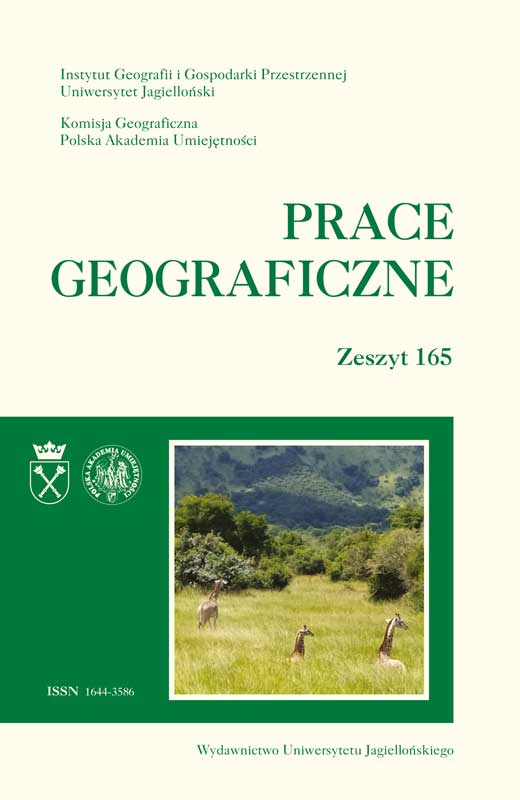Zmiany usłonecznienia rzeczywistego w Polsce i ich przyczyny (1966–2018)
Changes in sunshine duration in Poland and their causes (1966–2018)
Author(s): Andrzej A. Marsz, Anna StyszyńskaSubject(s): Geography, Regional studies, Regional Geography, Historical Geography
Published by: Wydawnictwo Uniwersytetu Jagiellońskiego
Keywords: sunshine duration; Poland; macro-circulation processes; thermohaline circulation; North Atlantic; usłonecznienie; Polska; procesy makrocyrkulacyjne; cyrkulacja termohalinowa; Atlantyk Północny
Summary/Abstract: W pracy omówiono zmiany usłonecznienia rzeczywistego nad Polską, zachodzące w latach 1966–2018. Zasadniczą analizę przeprowadzono dla szeregu rocznego usłonecznienia obszarowego, obliczonego z 11 stacji względnie równomiernie rozłożonych na obszarze Polski (zmienna UPLRK). Stwierdzono w przebiegu UPLRK wystąpienie nieciągłości, polegającej na skokowym wzroście tej wielkości w latach 1987–1989, a następnie pojawienia się w nim statystycznie istotnego trendu dodatniego. Zmiana przebiegu UPLRK i całkowita zmiana reżimu usłonecznienia nastąpiła w momencie zmiany „epok cyrkulacyjnych”, charakteryzowanych przez zmianę struktury frekwencji makrotypów cyrkulacji środkowotroposferycznej W, E i C według klasyfikacji Wangengejma-Girsa. Frekwencja tych makrotypów, poprzez sterowanie zmiennością cyrkulacji dolnej (polami SLP), steruje zmianami usłonecznienia. Wzrost frekwencji makrotypu W, z którym wartości UPLRK skorelowane są dodatnio, i jednoczesny spadek makrotypu E, z którym usłonecznienie skorelowane jest ujemnie, jaki nastąpił w momencie zmiany epok makrocyrkulacyjnych w latach 1987–1989, pociągnął za sobą odpowiednie zmiany zachowania się przebiegu usłonecznienia nad Polską. Zmiany frekwencji makrotypów W oraz E sterowane są przez zmiany rozkładu zasobów ciepła w poszczególnych akwenach Atlantyku Północnego. Tymi zmianami sterują zmiany cyrkulacji termohalinowej na Atlantyku Północnym (NA THC). W rezultacie obserwowane w latach 1966–2018 zmiany UPLRK odtwarzają zmiany zarówno warunków makrocyrkulacyjnych w atlantycko-europejskim sektorze cyrkulacyjnym, jak i zmiany faz NA THC. Pozwala to na twierdzenie, że zmienność UPLRK stanowi rezultat działania wewnętrznej dynamiki systemu klimatycznego, a nie stanowi, jak do tej pory się uważa, skutków antropogenicznych zmian koncentracji aerozoli w atmosferze. [The study discusses changes in the sunshine duration in Poland, occurring in the years 1966–2018. The main analysis was carried out on a series of annual area sunshine duration, calculated from 11 stations, distributed relatively evenly throughout the area of Poland (variable UPLRK). A discontinuity was found in the course of UPLRK, consisting a quantum leap of this value in the years 1987–1989, and then the appearance of a statistically significant positive trend in the course of UPLRK. A change in the course of UPLRK and the total change in the sunshine duration regime occurred at the moment of change in ‘circulation epochs’, characterized by a change in the frequency structure of the mid-tropospheric circulation of macro-types W, E and C according to the Wangengejm-Girs classification. The frequency of these macro-types, by controlling the variability of the lower circulation (SLP fields), controls changes in sunshine duration. An increase in the frequency of the W macro-type, with which the UPLRK values are positively correlated, and a simultaneous decrease in the frequency of the E macro-type, with which sunshine duration is negatively correlated, which occurred at the time of change of macro-circulation epochs in 1987–1989, resulted in corresponding changes in the behavior of the sunshine duration process in Poland. Changes in the frequencies of the W and E macro-types are controlled by changes in the distribution of heat resources in particular waters of the North Atlantic. These changes are controlled by changes in the North Atlantic Thermohaline Circulation (NA THC). As a result, the changes in the UPLRK observed in the years 1966–2018 reconstruct changes in both the macro-circulation conditions in the Atlantic-European circulation sector and changes in the NA THC phases. This allows for a conclusion that the variability of UPLRK is a result of the internal dynamics of the climate system, and not, as it has been believed so far, the effects of anthropogenic changes in the concentration of aerosols in the atmosphere.]
Journal: Prace Geograficzne
- Issue Year: 2021
- Issue No: 165
- Page Range: 23-52
- Page Count: 36
- Language: Polish

